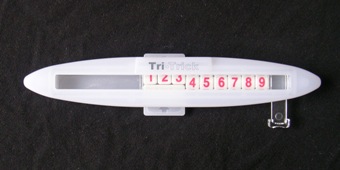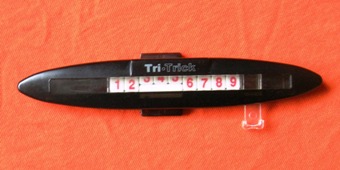



Tri-Trick is a puzzle made by Hidden One Design. It contains nine square tiles numbered 1 to 9, and one blank 1 by 3 rectangular tile. The puzzle has a horizontal slider that is 1 by 9, and a vertical plunger that is 2 by 3. They have a 1 by 3 area in common. Initially the horizontal slider has the tiles 1 to 9 in order. By moving the slider any three adjacent tiles can be brought into the plunger. The plunger is initially down, and contains the 1 by 3 rectangular tile. By moving the plunger up, any three adjacent number tiles can be swapped out for the rectangular piece.
If your browser supports it, you can click on the link below to play with a Javascript version of Tri-Trick.
I ran a computer search to find the number of positions at each distance from the solved position. Only moves of the plunger are counted as moves. The results are shown in the tables below. It shows that it can always be solved in at most 17 moves (12.428 on average). The second table shows the results if tile 9 is never moved, i.e. a shorter version of the puzzle is played. Similarly the last table is for when only 1-7 are moved and 8 and 9 are kept fixed.
| 1-9 | 1-8 | 1-7 | ||||||||||||||||||||||||||||||||||||||||||||||||||||||||||||||||||||||||||||||||||||||||||||||||||||||||||||||||||||||||||||||||||||||||||||||||||||||||||||||||||||
|---|---|---|---|---|---|---|---|---|---|---|---|---|---|---|---|---|---|---|---|---|---|---|---|---|---|---|---|---|---|---|---|---|---|---|---|---|---|---|---|---|---|---|---|---|---|---|---|---|---|---|---|---|---|---|---|---|---|---|---|---|---|---|---|---|---|---|---|---|---|---|---|---|---|---|---|---|---|---|---|---|---|---|---|---|---|---|---|---|---|---|---|---|---|---|---|---|---|---|---|---|---|---|---|---|---|---|---|---|---|---|---|---|---|---|---|---|---|---|---|---|---|---|---|---|---|---|---|---|---|---|---|---|---|---|---|---|---|---|---|---|---|---|---|---|---|---|---|---|---|---|---|---|---|---|---|---|---|---|---|---|---|---|---|---|---|---|
|
|
|
The four antipodes for the standard puzzle are:
![]()
![]()
![]()
![]()
The two antipodes for the 1-7 puzzle are:
![]()
![]()
Here are three simple move sequences that, applied to a row of seven numbered tiles, can be used to swap around three of the tiles. The solution that follows will use these sequences.
| Outer cycle: | Inner cycle: | Side cycle: | ||||||||||||||||||||||||||||||||||||||||||||||||||||||||||||||||||||||||||||||||||||||||||||||||||||||||||||||||||||||||||||||||||||||||||||||||||||||||||||||||||||||||||||||||||||||||||||||||||||||||||||
|---|---|---|---|---|---|---|---|---|---|---|---|---|---|---|---|---|---|---|---|---|---|---|---|---|---|---|---|---|---|---|---|---|---|---|---|---|---|---|---|---|---|---|---|---|---|---|---|---|---|---|---|---|---|---|---|---|---|---|---|---|---|---|---|---|---|---|---|---|---|---|---|---|---|---|---|---|---|---|---|---|---|---|---|---|---|---|---|---|---|---|---|---|---|---|---|---|---|---|---|---|---|---|---|---|---|---|---|---|---|---|---|---|---|---|---|---|---|---|---|---|---|---|---|---|---|---|---|---|---|---|---|---|---|---|---|---|---|---|---|---|---|---|---|---|---|---|---|---|---|---|---|---|---|---|---|---|---|---|---|---|---|---|---|---|---|---|---|---|---|---|---|---|---|---|---|---|---|---|---|---|---|---|---|---|---|---|---|---|---|---|---|---|---|---|---|---|---|---|---|---|---|---|---|---|---|---|
|
|
| ||||||||||||||||||||||||||||||||||||||||||||||||||||||||||||||||||||||||||||||||||||||||||||||||||||||||||||||||||||||||||||||||||||||||||||||||||||||||||||||||||||||||||||||||||||||||||||||||||||||||||||
Note that Inner Cycle is an Outer Cycle sandwiched by swaps of outer blocks, and that a Side Cycle is an Inner Cycle sandwiched by swaps of the left blocks. These move sequences use only 7 of the 9 tiles, so you can apply them to the left, right or middle seven tiles.
Phase 1: Solve tile 9
Phase 2: Solve tile 8
Phase 3: Solve tile 1
Phase 4: Solve parity
A note about parity: From now on we use the 3-cycle move sequences to solve the puzzle. These are even permutations, so they can only solve the puzzle if it is in a position that is an even permutation. On the physical puzzle there is an easy way to determine this: If the plunger is down it is an even permutation, and if it is up it is an odd permutation. Phase 4 above fixes the parity by making a swap. This assumes however that the plunger was down when it was originally in the solved position. While this is true for most physical versions of the puzzle, the online version on the manufacturer's home page does not model this properly. In that case you cannot determine from the plunger position what the parity of the permutation is. This may mean that after following the rest of the solution you end up with a position in which exactly two tiles need to be switched. In that case just apply the swap mentioned in phase 4, regardless of the plunger position, and try again to solve it.
Phase 5: Solve tile 2
Phase 6: Solve tile 3
Phase 7: Solve tile 4
Phase 8: Solve tiles 5, 6, 7